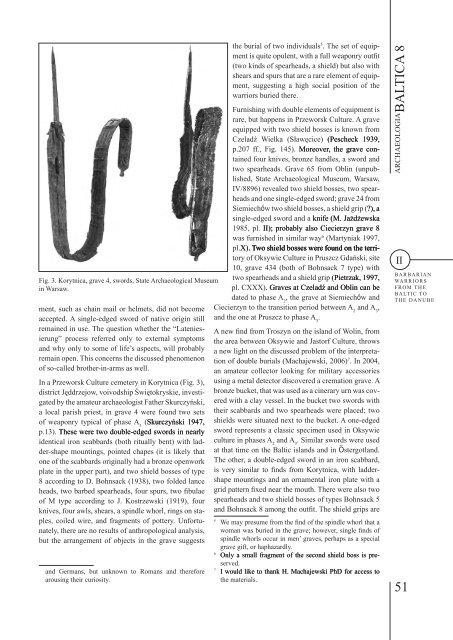BALTICA8 - Klaipėdos universitetas
BALTICA8 - Klaipėdos universitetas
BALTICA8 - Klaipėdos universitetas
- TAGS
- universitetas
- www.ku.lt
Create successful ePaper yourself
Turn your PDF publications into a flip-book with our unique Google optimized e-Paper software.
Fig. 3. Korytnica, grave 4, swords, State Archaeological Museum<br />
in Warsaw.<br />
ment, such as chain mail or helmets, did not become<br />
accepted. A single-edged sword of native origin still<br />
remained in use. The question whether the “Lateniesierung”<br />
process referred only to external symptoms<br />
and why only to some of life’s aspects, will probably<br />
remain open. This concerns the discussed phenomenon<br />
of so-called brother-in-arms as well.<br />
In a Przeworsk Culture cemetery in Korytnica (Fig. 3),<br />
district Jęddrzejow, voivodship Świętokryskie, investigated<br />
by the amateur archaeologist Father Skurczyński,<br />
a local parish priest, in grave 4 were found two sets<br />
of weaponry typical of phase A �Skurczyński Skurczyński 1947,<br />
3<br />
p.13). These were two double-edged swords in nearly<br />
identical iron scabbards (both ritually bent) with ladder-shape<br />
mountings, pointed chapes (it is likely that<br />
one of the scabbards originally had a bronze openwork<br />
plate in the upper part), and two shield bosses of type<br />
8 according to D. Bohnsack (1938), two folded lance<br />
heads, two barbed spearheads, four spurs, two fibulae<br />
of M type according to J. Kostrzewski (1919), four<br />
knives, four awls, shears, a spindle whorl, rings on staples,<br />
coiled wire, and fragments of pottery. Unfortunately,<br />
there are no results of anthropological analysis,<br />
but the arrangement of objects in the grave suggests<br />
and Germans, but unknown to Romans and therefore<br />
arousing their curiosity.<br />
the burial of two individuals � . The set of equipment<br />
is quite opulent, with a full weaponry outfit<br />
(two kinds of spearheads, a shield) but also with<br />
shears and spurs that are a rare element of equipment,<br />
suggesting a high social position of the<br />
warriors buried there.<br />
Furnishing with double elements of equipment is<br />
rare, but happens in Przeworsk Culture. A grave<br />
equipped with two shield bosses is known from<br />
Czeladź Wielka �Sławęcice) �Pescheck (Pescheck 1939,<br />
p.2�7 ff., Fig. 14�). Moreover, the grave con- contained<br />
four knives, bronze handles, a sword and<br />
two spearheads. Grave 6� from Oblin (unpublished,<br />
State Archaeological Museum, Warsaw,<br />
IV�8896) revealed two shield bosses, two spearheads<br />
and one single-edged sword; grave 24 from<br />
Siemiechów two shield bosses, a shield grip (?), ?), a<br />
single-edged sword and a knife �M. �M. Ja�d�ewska Ja�d�ewska<br />
198�, pl. II); probably also Ciecierzyn grave 8<br />
was furnished in similar way6 (Martyniak 1997,<br />
pl.X). X). . Two Two shield shield bosses bosses were were found found on on the the terri-<br />
territory<br />
of Oksywie Culture in Pruszcz Gdański, site<br />
1�, grave 434 �both of Bohnsack 7 type) with<br />
two spearheads and a shield grip (Pietrzak, 1997,<br />
pl. CXXX). . Graves at Czeladź and Oblin can be<br />
dated to phase A 2 , the grave at Siemiechów and<br />
Ciecierzyn to the transition period between A 2 and A 3 ,<br />
and the one at Pruszcz to phase A 3 .<br />
A new find from �roszyn on the island of Wolin, from<br />
the area between Oksywie and Jastorf Culture, throws<br />
a new light on the discussed problem of the interpretation<br />
of double burials �Machajewski, 2��6) 7 . In 2��4,<br />
an amateur collector looking for military accessories<br />
using a metal detector discovered a cremation grave. A<br />
bronze bucket, that was used as a cinerary urn was covered<br />
with a clay vessel. In the bucket two swords with<br />
their scabbards and two spearheads were placed; two<br />
shields were situated next to the bucket. A one-edged<br />
sword represents a classic specimen used in Oksywie<br />
culture in phases A 2 and A 3 . Similar swords were used<br />
at that time on the Baltic islands and in Östergotland.<br />
The other, a double-edged sword in an iron scabbard,<br />
is very similar to finds from Korytnica, with laddershape<br />
mountings and an ornamental iron plate with a<br />
grid pattern fixed near the mouth. �here were also two<br />
spearheads and two shield bosses of types Bohnsack �<br />
and Bohnsack 8 among the outfit. �he shield grips are<br />
� We may presume from the find of the spindle whorl that a<br />
woman was buried in the grave�� however, single finds of<br />
spindle whorls occur in men’ graves, perhaps as a special<br />
grave gift, or haphazardly.<br />
6 Only a small fragment of the second shield boss is pre- pre-<br />
served.<br />
7 I would like to thank H. Machajewski Ph�� Ph�� for access to<br />
the materials.<br />
ARCHAEOLOGIA BALTICA 8<br />
II<br />
BARBARIAN<br />
WARRIORS<br />
FROM THE<br />
BALTIC TO<br />
THE DANUBE<br />
�1

















